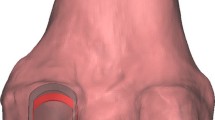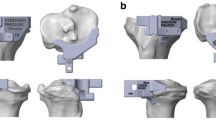Abstract
Purpose
Patient-specific instruments (PSI) were initially developed for the alignment of both total knee- (TKA) and partial knee arthroplasty (PKA). We hypothesize that CT-based PSI for PKA-to-TKA revision surgery can restore biomechanical limb alignment and prosthetic component positioning in vivo as calculated pre-operatively, resulting in a limited percentages of outliers.
Methods
An imaging analysis was performed using CT-based 3D measurement methods based on a pre- and post-revision CT scan. Imaging data were gathered on 10 patients who were operated for PKA-to-TKA revision with the use of PSI based on CT imaging. The planned femur and tibia component position in vivo were compared with the pre-revision planned component position. Outliers were defined as deviations >3.0° from pre-revision planned position for the individual implant components. Adjustments (e.g. resection level and implant size) during surgery were recorded.
Results
The HKA axis was restored accurately in all patients with a mean post-operative HKA axis of 178.1° (1.4°). Five femoral (2 varus, 2 internal rotation and 1 extension) and 14 tibial guides (2 varus, 6 anterior slope, 3 internal rotation and 3 external rotation) on a total of 60 outcome measures were identified as outliers. During surgery, an intraoperative tibial resection of 2 mm extra was performed in three patients. In 80 and 70% for, respectively, the femur and tibia, the surgeon-planned size was implanted during surgery. All patient-specific guides fitted well in all patients. No intraoperative or post-operative complications related to surgery were registered.
Conclusions
This study introduced a unique new concept regarding PSI, PKA-to-TKA revision surgery. Based on the results, we were unable to fully confirm our hypothesis. PSI as a “new” tool for PKA-to-TKA revision surgery appears to be an accurate tool for the alignment of the TKA femur component. The tibial guide seems more susceptible to errors, resulting in a substantial percentage of outliers.
Level of evidence
Prospective cohort study, Level II.
Similar content being viewed by others
References
Bargren JH, Blaha JD, Freeman MA (1973) Alignment in total knee arthroplasty Correlated biomechanical and clinical observations. Clin Orthop Relat Res 173:178–183
Berhouet J, Beaufils P, Boisrenoult P, Frasca D, Pujol N (2011) Rotational positioning of the tibial tray in total knee arthroplasty: a CT evaluation. Orthop Traumatol Surg Res 97:699–704
Boonen B, Schotanus MG, Kerens B et al (2015) Patient-specific positioning guides for total knee arthroplasty: no significant difference between final component alignment and pre-operative digital plan except for tibial rotation. Knee Surg Sports Traumatol Arthrosc. doi:10.1007/s00167-015-3661-1
Borrego Paredes E, Barrena Sánchez P, Serrano Toledano D, Puente González Al, Fornell Pérez S, Domecq Fernández de Bobadilla G (2017) Total knee arthroplasty after failed unicompartmental knee arthroplasty. Clinical results, radiologic findings, and technical tips. J Arthroplasty 32(1):193–196
Confalonieri N, Manzotti A, Chemello C, Cerveri P (2010) Computer-assisted revision of failed unicompartmental knee arthroplasty. Orthopedics 33(10):52–57
Dudley TE, Gioe TJ, Sinner P, Mehle S (2008) Registry outcomes of unicompartmental knee arthroplasty revisions. Clin Orthop Relat Res 466(7):1666–1670
Frye BM, Najim AA, Adams JB, Berend KR, Lombardi AV Jr (2015) MRI is more accurate than CT for patient-specific total knee arthroplasty. Knee 22:609–612
Graw BP, Harris AH, Tripuraneni K, Giori NJ (2010) Rotational references for total knee arthroplasty tibial components change with level of resection. Clin Orthop Relat Res 468:2734–2738
Heyse TJ, Tibesku CO (2014) Improved femoral component rotation in TKA using patient-specific instrumentation. Knee 21(1):268–271
Huddleston JI, Scott RD, Wimberley DW (2005) Determination of neutral tibial rotational alignment in rotating platform TKA. Clin Orthop Rel Res 440:101–110
Issa K, Rifai A, McGrath MS, Callaghan JJ et al (2013) Reliability of templating with patient-specific instrumentation in total knee arthroplasty. J Knee Surg 26(6):429–434
Jeffery RS, Morris RW, Denham RA (1991) Coronal alignment after total knee replacement. J Bone Joint Surg Br 73:709–771
Jones HW, Chan W, Harrison T et al (2012) Revision of medial Oxford unicompartmental knee replacement to a total knee replacement: similar to a primary? Knee 19(4):339–343
Jonkergouw F, Allé F, Chellaoui K, Vander Sloten J, Vangeneugden D (2016) Three-dimensional measurement technique to assess implant position and orientation after total knee arthroplasty. Med Eng Phys 38(12):1513–1517
Kerens B, Boonen B, Schotanus MGM, Kort NP (2013) Patient-specific guide for revision of medial unicondylar knee arthroplasty to total knee arthroplasty beneficial first results of a new operating technique performed on 10 patients. Acta Orthop 84(2):165–169
Khan Z, Nawaz SZ, Kahane S, Esler C, Chatterji U (2013) Conversion of unicompartmental knee arthroplasty to total knee arthroplasty: the challenges and need for augments. Acta Orthop Belg 79(6):699–705
Köster G, Biró C (2016) Total and unicompartmental knee replacement: patient-specific instrumentation. Orthopade 45(4):302–313
Levine B, Fabi D, Deirmengian C (2010) Digital templating in primary total hip and knee ar-throplasty. Orthopedics 33(11):797
Mahaluxmivala J, Bankes MJK, Nicolai P, Aldam CH, Allen PW (2001) The effect of surgeon experience on component positioning in 673 press fit condylar posterior cruciate sacrificing total knee arthroplasties. J Arthroplast 16(5):635–640
Mannan A, Smith TO (2016) Favourable rotational alignment outcomes in PSI knee arthroplasty: a level 1 systematic review and meta-analysis. Knee 23(2):186–190
McAuley JP, Engh GA, Ammeen DJ (2001) Revision of failed unicompartmental knee arthroplasty. Clin Orthop Relat Res 392:279–282
Oduwole KO, Sayana MK, Onayemi F et al (2009) Analysis of revision procedures for failed unicondylar knee replacement. Ir J Med Sci 179(3):361–364
Ritter MA, Faris PM, Keating EM, Meding JB (1994) Postoperative alignment of total knee replacement. its effect on survival. Clin Orthop Relat Res 299:153–156
Sarraf KM, Konan S, Pastides PS, Haddad FS, Oussedik S (2013) Bone loss during revision of unicompartmental to total knee arthroplasty: an analysis of implanted polyethylene thickness from the National Joint Registry data. J Arthroplast 28(9):1571–1574
Sassoon A, Nam D, Nunley R, Barrack R (2015) Systematic review of patient-specific instrumentation in total knee arthroplasty: new but not improved. Clin Orthop Relat Res 473:151–158
Schotanus MG, van Haaren EH, Hendrickx RP et al (2015) Accuracy of CT-based patient specific guides for total knee arthroplasty in patients with post-traumatic osteoarthritis and retained metal hardware around the knee joint from previous surgery. Eur J Orthop Surg Traumatol 25(8):1313–1320
Schotanus MG, Schoenmakers DA, Sollie R, Kort NP (2016) Patient-specific instruments for total knee arthroplasty can accurately predict the component size as used peroperative. DOI, Knee Surg Sports Traumatol Arthrosc. doi:10.1007/s00167-016-4345-1
Schotanus MG, Sollie R, van Haaren EH, Hendrickx RP et al (2016) Radiological discrepancy between MRI- and CT-based patient specific matched guides for total knee arthroplasty from the same manufacturer. A randomized controlled trial. Bone Joint J 98(6):786–792
Silva A, Pinto E, Sampaio R (2016) Rotational alignment in patient-specific instrumentation in TKA: MRI or CT? Knee Surg Sports Traumatol Arthrosc 24(11):3648–3652
Thienpont E, Schwab PE, Fennema P (2014) A systematic review and meta-analysis of patient-specific instrumentation for improving alignment of the components in total knee replacement. Bone Joint J. 96-B(8):1052–1061
Thienpont E, Schwab P, Fennema P (2017) Efficacy of patient-specific instruments in total knee arthroplasty a systematic review and meta-analysis. J Bone Joint Surg Am 99:521–530
Acknowledgements
The authors would like to thank Mr. K. Chellaoui for his expertise and work on measuring the radiographic alignments with the use of shape-match technology.
Author information
Authors and Affiliations
Contributions
MGMS: Designed the study, gathered and analyzed all the data, wrote the initial draft of the manuscript and managed the study; ET: Analyzed the data, wrote and revised the manuscript; BB: Ensured the accuracy of the data, revised the manuscript; BK, BJ: Designed the study, ensured the accuracy of the data and revised the manuscript; NPK: Conceived the study and revised the manuscript.
Corresponding author
Ethics declarations
Conflict of interest
One author (NK) is a paid consultant for Zimmer Biomet, Europe. The other authors certify that they have no commercial associations (e.g. consultancies, stock ownership, equity interest and patent/licensing arrangements) that might pose a conflict of interest in connection with the submitted manuscript.
Funding
No funding was received for this study.
Ethical approval
For this type of study formal consent is not required.
Informed consent
For this type of study informed consent is not required.
Rights and permissions
About this article
Cite this article
Schotanus, M.G.M., Thijs, E., Boonen, B. et al. Revision of partial knee to total knee arthroplasty with use of patient-specific instruments results in acceptable femoral rotation. Knee Surg Sports Traumatol Arthrosc 26, 1656–1661 (2018). https://doi.org/10.1007/s00167-017-4674-8
Received:
Accepted:
Published:
Issue Date:
DOI: https://doi.org/10.1007/s00167-017-4674-8




